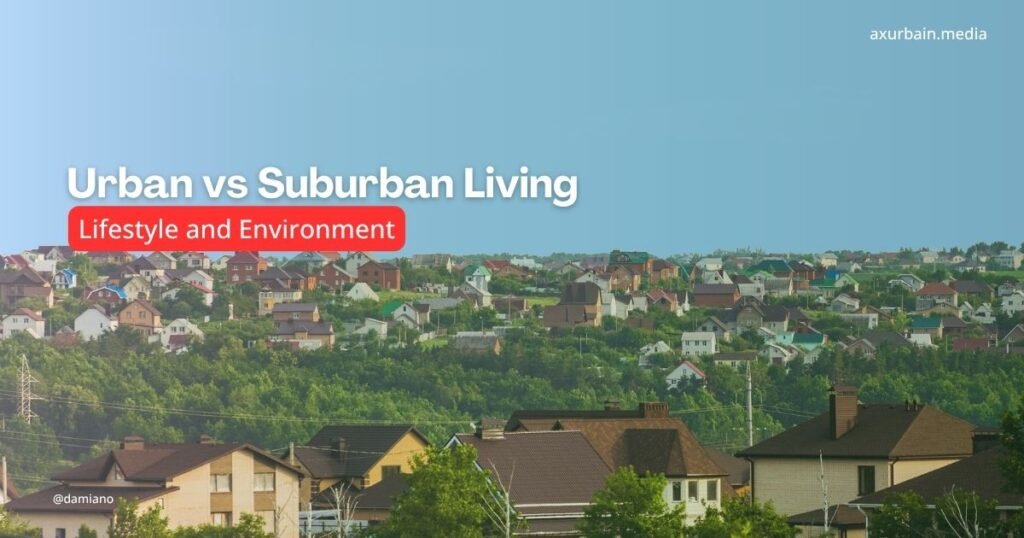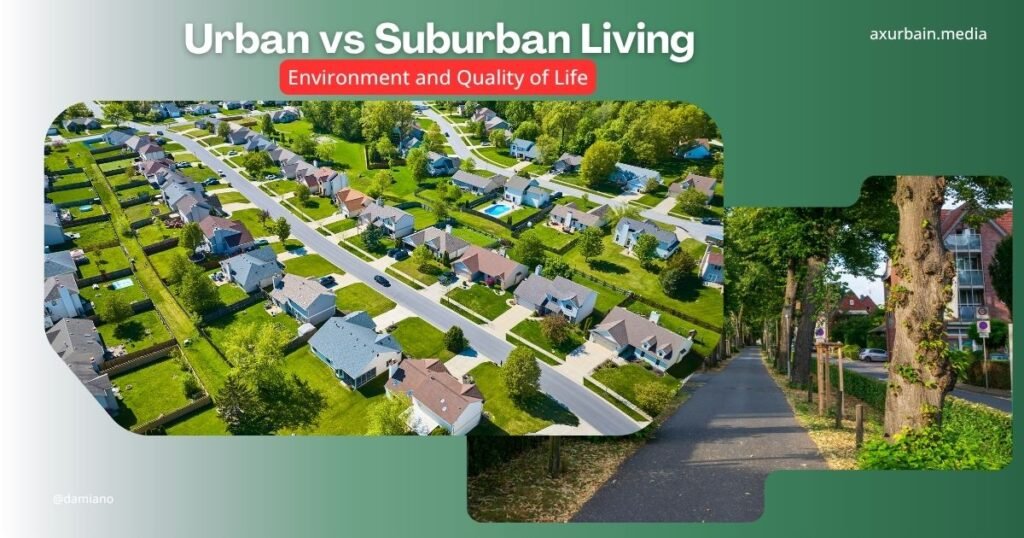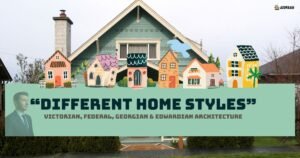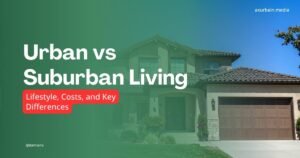This comparison matters more than ever today. Housing costs keep rising, remote work is changing where people choose to live, and lifestyle choices are shifting.
Some people move closer to the city for career growth and convenience. In contrast, others choose the suburbs for space, peace, and affordability.
The purpose of this guide is simple: to help you clearly understand the key differences between urban and suburban living so you can make better decisions about your lifestyle or your next move.
We will discuss in detail the differences between city life and suburban living. What are the key differences between two things and their future trends?
By the way, I am Damiano, you go to the expert for this whole guide. Keep engaged and let’s cover each thing one by one.
Table of Contents
ToggleWhat is urban vs suburban living?
Urban living means making your home in the heart of a city. Think of tall apartment buildings, busy streets, constant activity, and everything you need just a short walk or ride away. Life here is fast-paced, full of opportunities, and often very connected to work, culture, and entertainment.
Suburban living, on the other hand, usually happens on the edges of cities. These areas are more spread out, with larger houses, yards, and quieter neighborhoods. The pace is slower, there’s more personal space, and life often feels more family-friendly and community-based.
Now it’s become so easy to know about two types of living. The above definitions are the easiest one to know the difference.
Urban vs Suburban Living: Key Differences
Actually, there are a lot of differences. But we will cover some major ones to understand it better.
1. Lifestyle and Environment

Urban Living
Life in an urban area moves at a fast pace. There’s always something happening — from traffic sounds in the morning to city lights at night. People here often juggle busy schedules filled with work, social events, and activities.
Cities are full of cultural experiences. You can visit museums, art galleries, concerts, theaters, or try new restaurants anytime. This makes urban life exciting and varied, especially for people who enjoy exploring new things.
However, because cities are densely populated, living spaces are usually smaller. Apartments and condos are standard, and having your own yard is rare. Privacy can feel limited, but on the bright side, you’re surrounded by people, which often makes social life more active.
Urban environments also encourage more walking, public transport, and social interaction. You meet new faces daily, and networking is easier. The downside? Noise, traffic, and lack of quiet moments can make relaxing harder.
Suburban Living
Suburban life is much slower and calmer. It’s perfect for people who prefer peace, space, and community. The environment is less crowded, cleaner, and often greener — parks, playgrounds, and open areas everywhere.
Most suburban homes are larger, often with a yard or garden. Families enjoy this because it gives kids space to play and adults a place to relax outdoors. You’ll also have more privacy since houses aren’t packed closely together.
Suburbs are typically family-oriented. Schools, local markets, and neighborhood events build a strong sense of belonging. However, entertainment options are more limited. You might not find late-night cafes or live events as easily as in a city.
Still, many people find suburban living more balanced — less stress, more comfort, and a better environment for raising a family or simply enjoying a quieter lifestyle.
In short:
Let’s make it short and conclude the environment and lifestyle point of discussion.
- Urban living suits people who love energy, culture, and convenience.
- Suburban living fits those who value space, calmness, and a close-knit community.
We are talking about environment and lifestyle. You can take a look at guide where a micro-climate solution discussed in detail.
Read More: The Importance of Micro-Climate Creation for Urban Living
2. Housing and Cost of Living
What is Urban Housing and Suburban Housing?
- Urban Housing: In cities, most people live in apartments or condos. Space is limited, and rents are high because demand is strong. The closer you live to the city center, the more expensive it usually gets.
- Suburban Housing: Suburbs offer larger homes with yards or driveways. They are often more affordable per square foot, giving you more space for your money.
Key Factors to Depend:
Property Taxes and Utilities:
Property taxes vary; cities sometimes charge more for location benefits, while suburban homes may have higher utility bills because of their size.
Daily Expenses:
Groceries, dining out, and bare essentials are usually cheaper in suburban areas. At the same time, city prices are marked up due to higher operating costs.
What is the New Trend in Suburban Living? Cost Perspective
Since remote work became common, suburban housing prices have been rising. More people prefer space and peace over city convenience, driving up demand.
3. Transportation and Accessibility
Urban Living:
You can access public transit systems like subways, buses, and ride-sharing services in cities. Many areas are walkable, so you can reach shops, offices, and restaurants without a car. This makes daily commuting faster and often more convenient.
Suburban Living:
Suburban areas generally depend on cars. Public transport is limited, so commuting to work or city centers can take longer. People often face longer drives, especially during rush hours.
Traffic Congestion:
Urban areas can have heavy traffic, but good public transport can reduce car usage. In suburbs, fewer cars are around locally, but long commutes to the city can still lead to traffic jams.
Environmental Impact:
Daily commuting affects the environment. Urban public transit produces less pollution per person, while suburban car dependence contributes more to emissions and fuel use.
Future Trends in transport for urban living:
- Electric Vehicles (EVs) are becoming popular to reduce carbon footprints.
- Bike-sharing and e-scooters are improving short-distance travel in cities.
- Suburban areas are gradually seeing better connectivity, with expanded transit options and community-based transport solutions.
In short, Urban life offers convenience and walkability. In contrast, suburban life requires planning for car travel but is slowly improving with modern transport options.
4. Education and Healthcare
Urban Areas:
Cities usually offer access to top schools, universities, and research centers. Urban living gives you more choices if you want specialized programs or advanced education opportunities. Healthcare is also easier to access, with large hospitals, specialist doctors, and advanced medical facilities nearby.
If you wanna become more familiar with urban living pros and cons. Explore this guide.
Suburban Areas:
Suburbs have neighborhood schools, often with smaller student-teacher ratios, which can mean more individual attention for children. However, there are usually fewer specialized programs or higher-level institutions than in cities. Healthcare mainly comes from community clinics or smaller hospitals, so you might need to travel to the town for profound or specialized care.
In short, Urban living offers more choices and advanced services in education and healthcare. In contrast, suburban living provides smaller, closer-knit schools and basic medical access, making it ideal for families seeking a quieter environment.
5. Environment and Quality of Life

Urban Living:
City life often comes with pollution, noise, and limited green spaces. Traffic, construction, and crowded streets can make the environment stressful. On the positive side, urban areas provide access to cultural events, innovation, and modern amenities, keeping life dynamic and exciting.
Suburban Living:
Suburbs offer cleaner air, more parks, and a quieter environment. There’s more space for outdoor activities, gardening, and relaxation. The downside is dependence on cars, which can increase commute times and have an environmental impact.
Mental Health Considerations:
Urban living may lead to higher stress levels due to constant activity, noise, and crowded spaces. Suburban living often provides peace of mind, making it ideal for families or people seeking calmness.
Walkability vs Vehicle Dependence:
Cities encourage walking or using public transport. Suburbs usually require a car for daily tasks, affecting convenience and lifestyle choices.
6. Technology and Infrastructure
Urban Living:
Cities adopt new technologies faster. You’ll find high-speed internet, innovative city features, modern public services, and easy access to tech-driven conveniences like delivery apps, ride-sharing, and automated services.
Suburban Living:
Suburban areas are improving infrastructure, but some neighborhoods lack high-speed internet or advanced public facilities. This can affect remote work, entertainment, and access to tech-based services.
Future Trends:
Smart home technology and hybrid living solutions gradually bridge the gap between urban and suburban lifestyles. Suburban areas are becoming more connected, while metropolitan areas continue to innovate, offering residents the best of both convenience and comfort.
Future Trends: Urban vs Suburban in the Coming Decades
Impact of Remote and Hybrid Work:
The rise of remote and hybrid work is changing where people choose to live. Many professionals no longer need to commute daily to a city, making suburban living more attractive. People can enjoy larger homes, quieter neighborhoods, and green spaces while staying connected to city jobs online. This trend drives suburban growth, with new communities built to support remote workers.
Climate Change and Sustainable Living Choices:
As climate awareness grows, people are considering walkable cities versus eco-friendly suburbs. Urban areas increasingly promote public transport, bike lanes, and compact living to reduce carbon footprints. Suburbs focus on green spaces, solar energy, and sustainable housing designs. Future residents will choose locations that balance convenience, comfort, and environmental responsibility.
Younger Generations vs Families:
Younger adults often prefer city convenience, valuing nightlife, social events, and career opportunities. In contrast, families choose suburbs for space, safety, and good schools. This demographic split will shape urban and suburban planning in the coming decades, with each area catering to specific lifestyles.
Predictions on Urban Densification and Suburban Expansion:
- Urban areas are expected to become more densely populated, with taller buildings, mixed-use developments, and efficient public transport.
- Suburban areas will continue expanding, offering new residential communities, local shopping, and better city connectivity.
- Hybrid solutions like “suburban satellite hubs” may emerge, combining city conveniences with suburban comfort.
The future of living is flexible. Urban and suburban areas will evolve differently to meet lifestyle, work, and sustainability needs.
Choosing where to live will increasingly depend on personal priorities, family needs, career goals, and environmental values.
Comparison: Urban vs Suburban vs Rural Living
Nothing can give you more information than comparison. Below is the detailed comparison between City Living, Rural Living, and Suburban Living, covering multiple perspectives.
| Perspective | Urban Living | Suburban Living | Rural Living |
| Population & Density | Highly dense; many people live close together in apartments or condos. | Moderately dense; neighborhoods are spread out with single-family homes. | Low density; wide-open spaces, farms, and small communities. |
| Lifestyle & Environment | Fast-paced, always active, culturally vibrant with restaurants, theaters, and events. | Slower, family-oriented, quieter neighborhoods, more green spaces. | Very slow-paced, close to nature, quiet, and peaceful with minimal social events. |
| Housing & Space | Smaller apartments or condos; high cost per square foot; limited outdoor space. | Larger homes with yards; more affordable per square foot; more privacy. | Spacious homes or farmhouses; land available; very affordable, but amenities may be far away. |
| Cost of Living | High rent, expensive groceries, dining, utilities, and services. | Moderate cost; groceries and utilities slightly cheaper; housing more affordable than city. | Generally low cost; housing very affordable; limited shopping may increase travel costs. |
| Job Opportunities | Abundant, especially in corporate, tech, and creative sectors; higher competition. | Moderate; most commute to nearby cities; local jobs available in retail, schools, and services. | Limited; farming, small businesses, or remote work; fewer career opportunities. |
| Education | Access to top schools, universities, and specialized programs; many options. | Good neighborhood schools; smaller class sizes; fewer specialized programs. | Local schools; smaller, close-knit classes; fewer advanced programs; may require travel for higher education. |
| Healthcare | Large hospitals, specialists, advanced medical facilities nearby. | Community hospitals and clinics; serious care often requires city travel. | Basic healthcare services; limited access to specialists; travel to cities for advanced care. |
| Transportation | Excellent public transit; walkable; taxis and ride-sharing widely available. | Mostly car-dependent; longer commutes; improving connectivity. | Highly car-dependent; long distances to work, schools, and stores; minimal public transport. |
| Entertainment & Social Life | Endless options: cinemas, theaters, nightlife, festivals, restaurants. | Local events, parks, community gatherings; fewer entertainment options than cities. | Minimal; small local gatherings, outdoor activities; social life may require travel. |
| Community & Social Bonds | Diverse population; less close-knit; anonymity is common. | Strong neighborhood ties; friendly and family-focused community. | Very close-knit; everyone knows each other; strong community support. |
| Environment & Quality of Life | Higher pollution, noise, and traffic; limited green spaces; innovative lifestyle. | Cleaner air, quiet neighborhoods, parks, safer streets; car dependency. | Fresh air, minimal noise, lots of green space; simple and slow-paced life. |
| Technology & Infrastructure | Fast internet, smart city tech, modern amenities, advanced public services. | Improving internet and services; some areas still lag in connectivity. | Basic infrastructure; internet may be slow or limited; fewer modern services. |
| Future Trends | Continued densification, smart city expansion, more innovation and urban lifestyle options. | Suburban growth due to remote work; hybrid living solutions; better connectivity. | Slow growth; may see eco-tourism, renewable energy adoption, and remote work-driven settlements. |
| Ideal For | Young professionals, career-focused individuals, culture seekers. | Families, people seeking balance between city convenience and space. | Nature lovers, retirees, remote workers seeking peace and space. |
Conclusion
Urban and suburban living each have their unique strengths and challenges. Lifestyle, cost, community, and accessibility are the main contrasts. Cities offer fast-paced energy, cultural experiences, and easy access to jobs and services, but at higher costs and with less personal space. Suburbs provide larger homes, quieter neighborhoods, and more green spaces, but often require longer commutes and car dependency.
There is no one-size-fits-all choice. The best option depends on your personal goals: career growth, family life, or lifestyle preferences. Before deciding, carefully evaluate your priorities: do you value convenience and culture, or space and peace?
Ultimately, the decision is about finding the best environment that suits your life.
So, which would you choose: the city’s fast pace or the suburbs’ calm? Let me know in the comments.




